Apa itu analisis kasus penggunaan?
Diagram kasus penggunaan terutama digunakan untuk menggambarkan peran dan hubungan antara peran dan kasus penggunaan. Jelaskan siapa yang akan menggunakan sistem dan apa yang dapat mereka lakukan dengan itu.
Diagram kasus penggunaan berisi beberapa elemen model, seperti sistem, peserta, dan kasus penggunaan, dan menunjukkan berbagai hubungan antara elemen-elemen ini, seperti generalisasi, asosiasi, dan ketergantungan.
Ini menunjukkan diagram model fungsional dari sistem yang dapat diamati oleh pengguna eksternal. Kasus penggunaan membantu tim pengembang memahami kebutuhan fungsional sistem dengan cara visual.
Elemen-elemen Diagram Kasus Penggunaan
Diagram kasus penggunaan mengandung 6 elemen, yaitu
- Aktor
- Kasus Penggunaan
- Asosiasi
- Hubungan termasuk
- Hubungan diperluas (Extend)
- Hubungan generalisasi
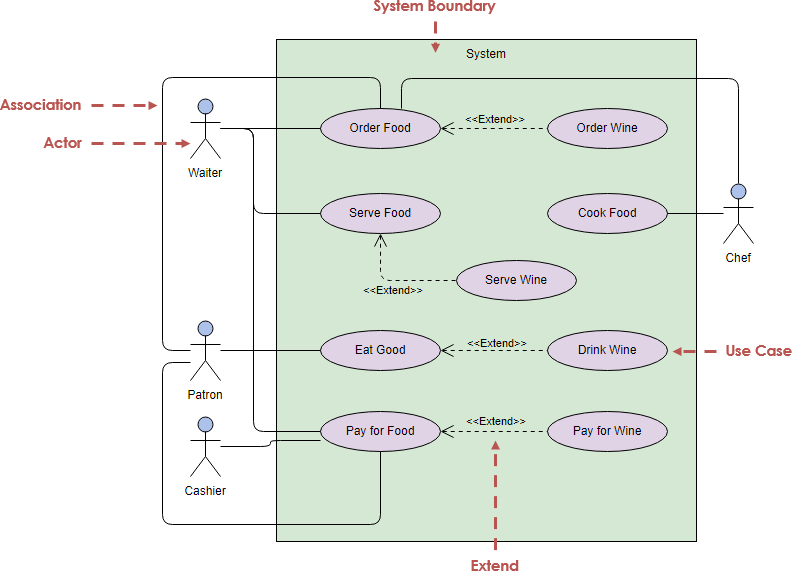
Sebagai alternatif, Anda dapat menempatkan batas sistem dalam diagram kasus penggunaan untuk menunjukkan ruang lingkup sistem.
Aktor
Apa saja peran yang menggunakan sistem ini? Peran yang berbeda menggunakan fungsi sistem yang berbeda, yang diwakili oleh penjahat dalam diagram kasus penggunaan.
- Entitas eksternal
- Berpartisipasi dalam proses eksekusi kasus penggunaan
- Aktor diwakili oleh peran yang mereka mainkan dalam berpartisipasi dalam kasus penggunaan
- Setiap aktor dapat berpartisipasi dalam satu atau lebih kasus penggunaan
Jenis-jenis Aktor
- Pengguna sistem – Orang nyata, pengguna, adalah aktor yang paling umum yang ada di hampir setiap sistem, dan mereka harus diberi nama sesuai dengan peran
Sistem lain yang berinteraksi dengan sistem yang sedang dibangun - Program eksternal — Contoh, ketika pelanggan belum mengembalikan mobil pada waktu pengembalian, sistem akan mengingatkan perwakilan layanan pelanggan untuk menghubungi pelanggan, dan waktu atau sistem eksternal menjadi pemain dalam sistem
- Lainnya termasuk perangkat keras, layanan eksternal, dan basis data eksternal
Bagaimana cara menemukan peserta sistem?
- Siapa yang akan menggunakan fungsi utama sistem
- Siapa yang akan membutuhkan dukungan sistem untuk melakukan pekerjaannya
- Siapa yang akan perlu memelihara dan mengelola sistem
- Perangkat keras mana yang perlu ditangani oleh sistem
- Sistem apa yang berinteraksi dengan sistem ini
Penggagas dan pendukung
- Siapa atau sistem apa yang tertarik pada hasil yang dihasilkan oleh sistem ini
- Inisiator adalah objek layanan utama dari kasus penggunaan
Yang lainnya adalah peserta yang memainkan peran sebagai pendukung
Hubungan antara kasus penggunaan
Hubungan asosiasi (ini mewakili hubungan antara peserta dan kasus penggunaan. Dalam UML, sering kali diwakili oleh garis lurus atau garis dengan panah yang menunjuk ke penerima informasi)

Menyusun Kasus Penggunaan dengan Hubungan
Hubungan extend / ekstensi (ini berarti bahwa perilaku baru ditambahkan ke kasus penggunaan yang ada di bawah kondisi tertentu. Kasus penggunaan baru yang diperoleh disebut kasus penggunaan yang diperluas, dan kasus penggunaan asli disebut kasus penggunaan dasar, yang setara dengan memberikan fungsi tambahan untuk kasus penggunaan dasar. Ini diwakili oleh garis putus-putus dengan panah dalam UML, dan panah menunjuk ke kasus penggunaan dasar)
Hubungan termasuk (ini berarti bahwa perilaku dari kasus penggunaan lain dapat disertakan, dan perilaku kasus penggunaan yang terkandung di dalamnya dapat dianggap sebagai bagian dari perilakunya sendiri. Ini sering diwakili oleh garis putus-putus dengan panah dalam UML, dan panah menunjuk ke kasus penggunaan yang termasuk)
Hubungan generalisasi (merujuk pada bahwa kasus penggunaan induk dapat dispesialisasikan untuk membentuk beberapa kasus penggunaan anak, dan hubungan antara kasus penggunaan induk dan kasus penggunaan anak adalah hubungan generalisasi. Dalam UML, diwakili oleh garis solid dengan panah segitiga berongga, dan panah menunjuk ke kasus penggunaan induk)
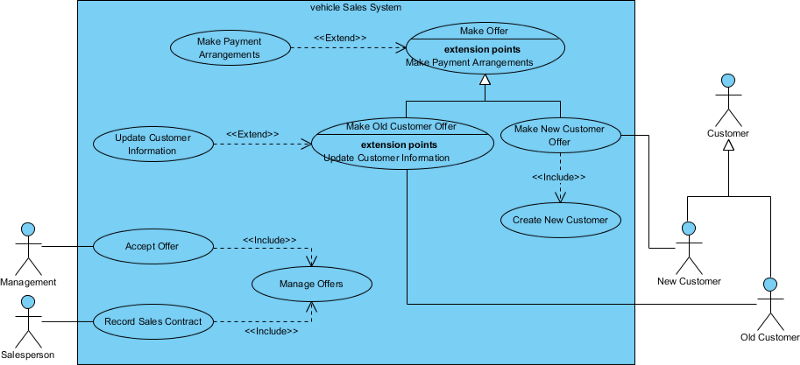
Contoh Kasus Penggunaan
Di sini saya memilih beberapa contoh dari Visual Paradigm Online yang seharusnya sudah cukup Anda kenal dengan bisnis, seperti ATM, DMS, dan sistem pemesanan. Gambar di bawah ini menunjukkan sebuahATMcontoh diagram kasus penggunaan, yang merupakan contoh klasik untuk digunakan dalam mengajarkan diagram kasus penggunaan.
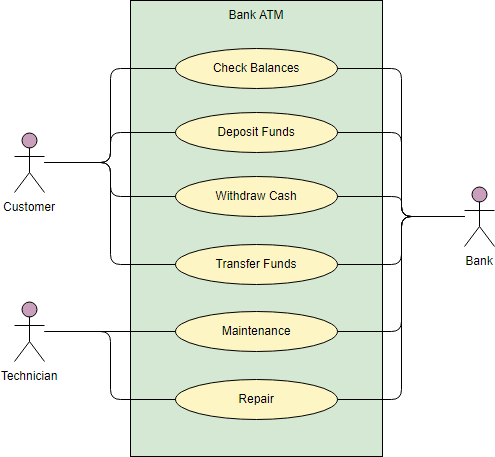
SistemSistem Manajemen Dokumen (DMS)contoh diagram kasus penggunaan di bawah ini menunjukkan aktor dan kasus penggunaan dari sistem. Secara khusus, terdapat hubungan termasuk dan diperluas di antara kasus penggunaan.
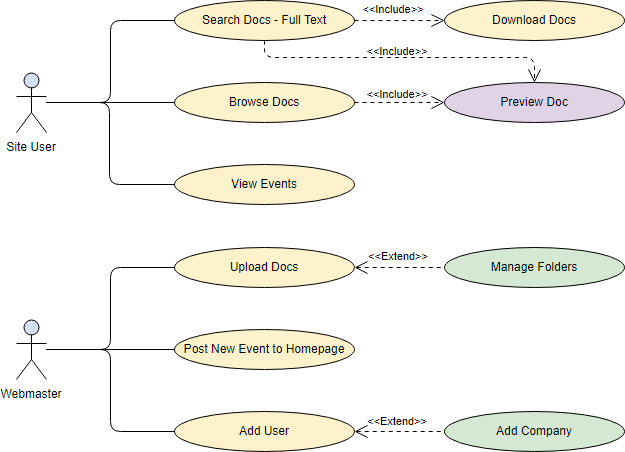
SistemSistem PemesananContoh diagram use case di bawah ini menunjukkan aktor dan use case yang terlibat dalam sistem:
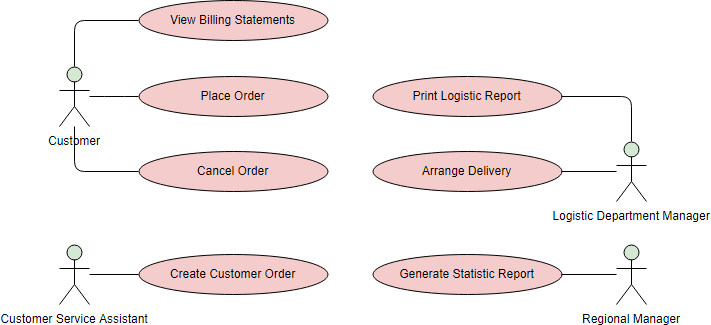
Pelajari Diagram UML Lainnya dan Artikel Terkait
- Mengapa Pemodelan UML?
- Ikhtisar 14 Tipe Diagram UML
- Apa itu Diagram Kelas?
- Apa itu Diagram Komponen?
- Apa itu Diagram Deployment?
- Apa itu Diagram Objek?
- Apa itu Diagram Paket?
- Apa itu Diagram Struktur Komposit?
- Apa itu Diagram Profil?
- Apa itu Diagram Use Case?
- Apa itu Diagram Aktivitas?
- Apa itu Diagram Mesin Status?
- Apa itu Diagram Urutan?
- Apa itu Diagram Komunikasi?
- Apa itu Diagram Ikhtisar Interaksi?
- Apa itu Diagram Waktu
- Apa itu Diagram Kolaborasi UML?
This post is also available in Deutsch, English, Español, فارسی, Français, 日本語, Polski, Portuguese, Ру́сский, Việt Nam, 简体中文 and 繁體中文.













